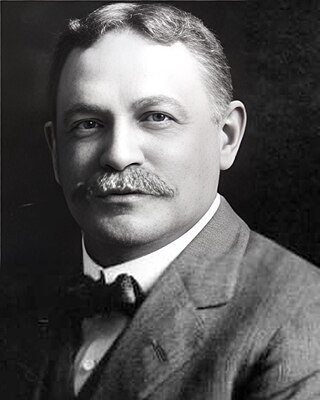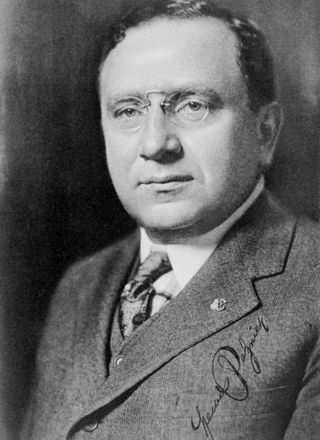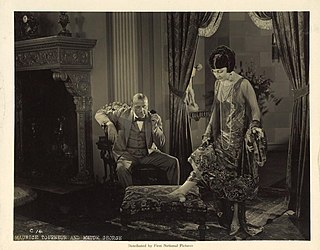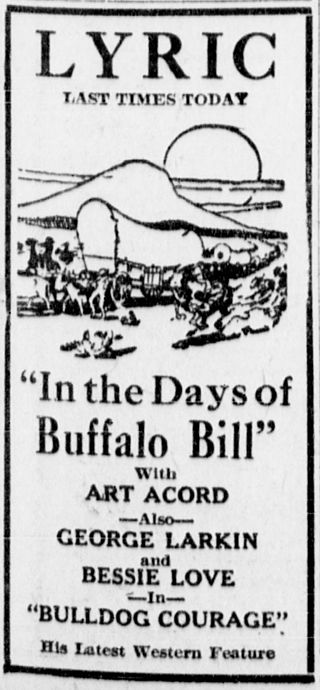Related Research Articles
A feature film or feature-length film, also called a theatrical film, is a narrative film with a running time long enough to be considered the principal or sole presentation in a commercial entertainment program. The term feature film originally referred to the main, full-length film in a cinema program that included a short film and often a newsreel. Matinee programs, especially in the US and Canada, in general, also included cartoons, at least one weekly serial and, typically, a second feature-length film on weekends.

The Biograph Company, also known as the American Mutoscope and Biograph Company, was a motion picture company founded in 1895 and active until 1916. It was the first company in the United States devoted entirely to film production and exhibition, and for two decades was one of the most prolific, releasing over 3000 short films and 12 feature films. During the height of silent film as a medium, Biograph was the most prominent U.S. film studio and one of the most respected and influential studios worldwide, only rivaled by Germany's UFA, Sweden's Svensk Filmindustri and France's Pathé. The company was home to pioneering director D. W. Griffith and such actors as Mary Pickford, Lillian Gish, and Lionel Barrymore.

William Nicholas Selig was a vaudeville performer and pioneer of the American motion picture industry. His stage billing as Colonel Selig would be used for the rest of his career, even as he moved into film production.

The Selig Polyscope Company was an American motion picture company that was founded in 1896 by William Selig in Chicago, Illinois. The company produced hundreds of early, widely distributed commercial moving pictures, including the first films starring Tom Mix, Harold Lloyd, Colleen Moore, and Roscoe "Fatty" Arbuckle. Selig Polyscope also established Southern California's first permanent movie studio, in the historic Edendale district of Los Angeles.

Lewis J. Selznick was an American producer in the early years of the film industry. After initial involvement with World Film at Fort Lee, New Jersey, he established Selznick Pictures in California.

Twentieth Century Pictures, Inc. was an American independent Hollywood motion picture production company created in 1933 by Joseph Schenck and Darryl F. Zanuck from Warner Bros. Pictures. The company product was distributed theatrically under United Artists (UA), and leased space at Samuel Goldwyn Studios.

The Bowery is a 1933 American pre-Code historical comedy-drama film set in the Lower East Side of Manhattan around the start of the 20th century directed by Raoul Walsh and starring Wallace Beery and George Raft. The supporting cast features Jackie Cooper, Fay Wray, and Pert Kelton.
Astor Pictures was a motion picture distribution company in the United States from 1930 to 1963. It was founded by Robert M. Savini. Astor specialized in film re-releases. It later released independently made productions, including some of its own films made during the 1950s.
Frederick J. Jackson, also known professionally as Fred Jackson and Frederick Jackson and under the pseudonym Victor Thorne, was an American author, playwright, screenwriter, novelist, and producer for both stage and film. A prolific writer of short stories and serialized novels, most of his non-theatre works were published in pulp magazines such as Detective Story Magazine and Argosy. Many of these stories were adapted into films by other writers.

Agnes Vernon was an American film actress of the silent era. While still in her teens, she experienced a meteoric ascent from obscurity to box-office sensation. After turning twenty-three and a movie career fading away, she abandoned the silver screen forever. Vernon performed in over 90 films between 1913 and 1922. She completed most of her roles under contract with Universal Pictures.

The Call of the Wild is a 1908 American short silent Western film directed by D. W. Griffith and produced by the American Mutoscope and Biograph Company. The short, a "one-reeler", stars Charles Inslee, Harry Solter and Florence Lawrence. Its interior scenes were shot at Biograph's studio facilities in New York City, and its exteriors were filmed on location in Coytesville, today one of the oldest communities in Fort Lee, New Jersey.
The Centaur Film Company was an American motion picture production company founded in 1907 in Bayonne, New Jersey, by William and David Horsley. It was the first independent motion picture production company in the United States. In 1909 the company added a West Coast production unit, the Nestor Film Company, which established the first permanent film studio in Hollywood, California, in 1911. The company was absorbed by the Universal Film Manufacturing Company in 1912.
The AFI Catalog of Feature Films, also known as the AFI Catalog, is an ongoing project by the American Film Institute (AFI) to catalog all commercially-made and theatrically exhibited American motion pictures from the birth of cinema in 1893 to the present. It began as a series of hardcover books known as The American Film Institute Catalog of Motion Pictures, and subsequently became an exclusively online filmographic database.

Torment is a 1924 American silent crime drama film produced and directed by Maurice Tourneur and distributed by Associated First National. This film stars Bessie Love, Owen Moore, and Jean Hersholt. The film is based on a story by William Dudley Pelley with script by Fred Myton and titles by Marion Fairfax. It is a lost film.
How Brown Saw the Baseball Game is an American short silent comedy film produced in 1907 and distributed by the Lubin Manufacturing Company. The film follows a baseball fan named Mr. Brown who overdrinks before a baseball game and becomes so intoxicated that the game appears to him in reverse motion. During production, trick photography was used to achieve this effect. The film was released in November 1907. It received a positive review in a 1908 issue of The Courier-Journal that reported the film was successful and "truly funny". As of 2021, it is unclear whether the print of the film has survived. The identities of the film cast and production crew are unknown. Film historians have noted similarities between the plot of How Brown Saw the Baseball Game and How the Office Boy Saw the Ball Game. It is a comedy film directed by Edwin S. Porter, having released a year before How Brown Saw the Baseball Game.

Bulldog Courage is a 1922 American silent Western film directed by Edward A. Kull, and starring George Larkin and Bessie Love. It was written by Larkin and his wife Ollie Kirkby, with a screenplay by Jeanne Poe. It was produced by Russell Productions and distributed by State Rights.

The Denver Dude is a 1927 American silent Western film directed by B. Reeves Eason and starring Hoot Gibson, Blanche Mehaffey, and Robert McKim. It was produced and distributed by Universal Pictures.
Harry Chandlee (1882–1956) was an American screenwriter and film editor and occasional producer. He co-wrote the screenplay for Sergeant York, which was nominated for the Academy Award for Best Original Screenplay at the 1941 Oscars.

The Broken Silence is a feature-length 1922 American film. An adaptation of a short story by James Oliver Curwood, it was directed by Dell Henderson for Pine Tree Pictures productions, and distributed by Arrow Film Corp. The Broken Silence is a melodrama love story involving a murder and devoted siblings, set in Canada's Northwest. Thomas F. Fallon adapted the screenplay.

A Sound Sleeper is a 1909 American comedy film directed by D. W. Griffith and produced by the American Mutoscope and Biograph Company. The short was filmed in one day in the Coytesville borough of Fort Lee, New Jersey, which at the time was a popular filming location for many early motion-picture studios in the northeastern United States. Due to the brief running time of this comedy, it was originally distributed in April 1909 on a split reel with another Biograph release, a longer dramatic film titled The Winning Coat.
References
- ↑ IMDb
- ↑ American Film Institute
- ↑ Elias Savada (ed.). The American Film Institute Catalog of Motion Pictures Produced in the United States: Film Beginnings, 1893–1910 — A Work in Progress: v. A. Scarecrow Press. ISBN 0-8108-3021-3.
- ↑ Lauritzen, Einar; Lundquist, Gunnar (1976). American Film-Index 1908–1915: Motion Pictures, July 1908–December 1915. distributed by Akademiebokhandeln, University of Stockholm. Stockholm: Film-Index. ISBN 91-7410-001-7.
- ↑ Plot Summary